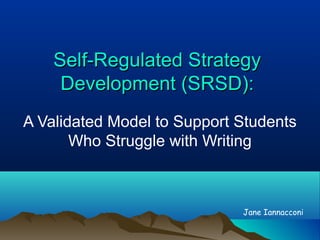
SRSD Model Supports Struggling Writers
- 1. Self-Regulated StrategySelf-Regulated Strategy Development (SRSD):Development (SRSD): A Validated Model to Support Students Who Struggle with Writing Jane Iannacconi
- 2. Writing is an extremelyWriting is an extremely challenging process for manychallenging process for many students, especially those withstudents, especially those with learning disabilities.learning disabilities.
- 3. Scaffolding instruction gradually shifts responsibility for use of the strategy and self- regulation procedures from instructor to student.
- 4. TheThe mnemonicmnemonic devicesdevices reviewed, discussed, andreviewed, discussed, and modeled during the first 3modeled during the first 3 stages may include:stages may include:
- 5. POWPOW -- for storyfor story planningplanning P – Pick my ideasP – Pick my ideas O – Organize my notesO – Organize my notes W – Write and say moreW – Write and say more
- 6. WWW + What 2, How 2WWW + What 2, How 2 All Seven Story PartsAll Seven Story Parts WW = Who are the main characters?= Who are the main characters? WW = Where does the story take place?= Where does the story take place? WW = When does the story take place?= When does the story take place? WW = What do the main characters want to do?= What do the main characters want to do? WW = What happens next?= What happens next? HH = How does the story end?= How does the story end? HH = How do the main characters feel?= How do the main characters feel?
- 7. TREE for Persuasive WritingTREE for Persuasive Writing TREE:TREE: NoteNote TTopic Sentenceopic Sentence NoteNote RReasonseasons EExamine Each Reason – Willxamine Each Reason – Will My Reader Buy It?My Reader Buy It? NoteNote EEndingnding
- 8. Use Graphic Organizers to Organize Notes • Who • Where • When • What • What • How • How
- 9. The SRSD Instructional ModelThe SRSD Instructional Model consists of 6 Stages:consists of 6 Stages: 1. Develop background knowledge 2. Discuss It 3. Model It 4. Memorize It 5. Support It 6. Establish Independent Practice
- 10. STAGE ONE:STAGE ONE: Develop Background KnowledgeDevelop Background Knowledge • Review and strengthen basic writing pre-skills such as vocabulary. • Review writing mnemonics.
- 11. Stage Two: Discuss ItStage Two: Discuss It Examine and discuss current writingExamine and discuss current writing performance and any existingperformance and any existing strategies being used.strategies being used. Get an idea of the students’Get an idea of the students’ perceptions of their current writingperceptions of their current writing process.process.
- 12. DiscussDiscuss What Makes A Good Story?What Makes A Good Story? Remind students that every good story: (a) makes sense (b) is fun to write and read (c) uses “million-dollar” words, and (d) includes all seven story parts.
- 13. Stage Three: Model ItStage Three: Model It UseUse self-talkself-talk to model writingto model writing strategies. Include:strategies. Include: Mnemonics, andMnemonics, and Self-regulating instructionsSelf-regulating instructions including positive personalincluding positive personal statements.statements.
- 14. Through SRSD, teachers helpThrough SRSD, teachers help students to learn about fourstudents to learn about four basic self-regulation strategies:basic self-regulation strategies: Goal settingGoal setting Self-MonitoringSelf-Monitoring Self-TalkSelf-Talk Self-ReinforcementSelf-Reinforcement
- 15. STAGE FOUR: MEMORIZE ITSTAGE FOUR: MEMORIZE IT Use flashcards, peer tutoring, and/orUse flashcards, peer tutoring, and/or whoever catches the Nerf ballwhoever catches the Nerf ball** to helpto help students memorize the strategy,students memorize the strategy, mnemonics, and positive self-talk.mnemonics, and positive self-talk. * Student Responds With Name Of Mnemonic* Student Responds With Name Of Mnemonic Or What A Particular Letter Stands For InOr What A Particular Letter Stands For In Mnemonic, EtcMnemonic, Etc..
- 16. STAGE FIVE: SUPPORT ITSTAGE FIVE: SUPPORT IT • Have students practice all they have learned so far. • Work in groups and/or pairs – especially when learning new strategies.
- 17. GoalGoal of Stage Fiveof Stage Five • To develop students’ skill in applying the strategy. • Ultimate Goal – Students no longer require assistance from the teacher or support from peers or instructional aids.
- 18. STAGE SIX -STAGE SIX - INDEPENDENT PERFORMANCEINDEPENDENT PERFORMANCE • During this stage, students independently use the writing strategy. • After they demonstrate they can consistently use the strategy and self-regulation techniques, the teacher can decide whether it is appropriate to fade the use of any unnecessary supports.
- 19. A QUOTEA QUOTE • One student with a learning disability said, “Of course now I can write a story! Someone showed me how.”* * The IRIS Center for Training Enhancements. (n.d.). Using learning strategies: Instruction to enhance student learning. Retrieved on 10/31/10. [Under “Resources”] http://iris.peabody.vanderbilt.edu/srs/chalcycle.htm
- 20. Important ResourceImportant Resource The IRIS Center for Training Enhancements. (n.d.). Using learning strategies: Instruction to enhance student learning. Retrieved on 10/31/10. http://iris.peabody.vanderbilt.edu/srs/chalcycle.htm Click on “Perspectives and Resources” on star module. Then click on pages 4 – 10, respectively, and scroll to bottom of each page for videos of implementation of SRSD.
- 21. ReferencesReferences • Santangelo, T., Harris, K.R., & Graham, S. (2007). Self-regulated strategy development: A validated model to support students who struggle with writing. Learning Disabilities: A Contemporary Journal, 5(1), 1-20.
